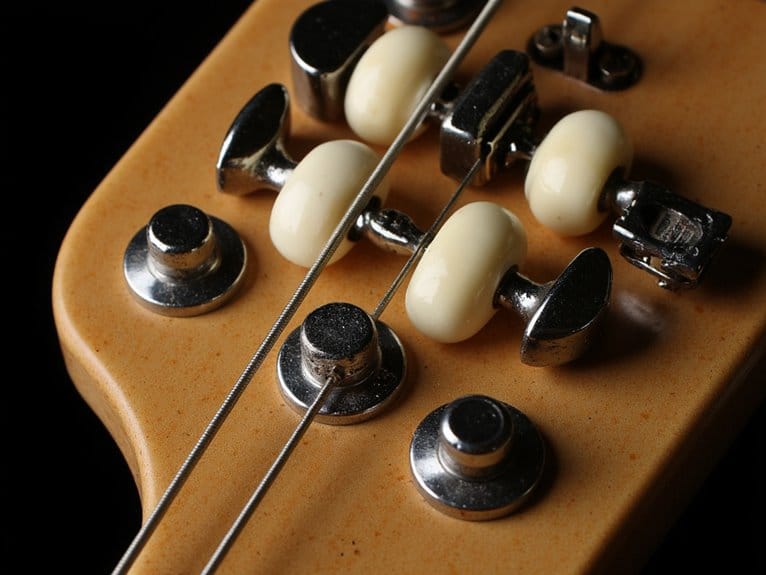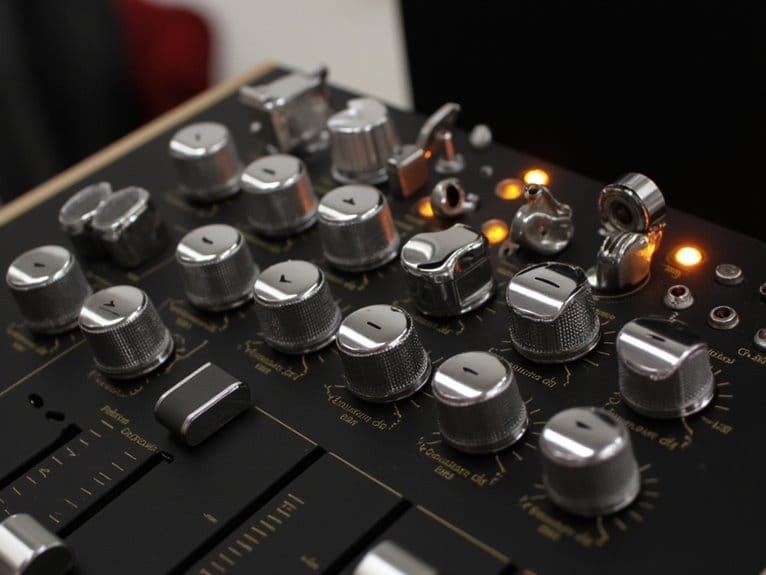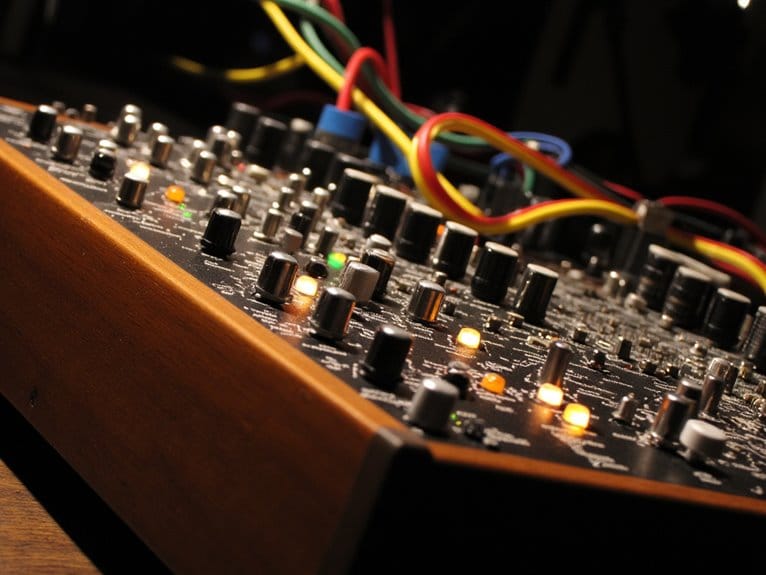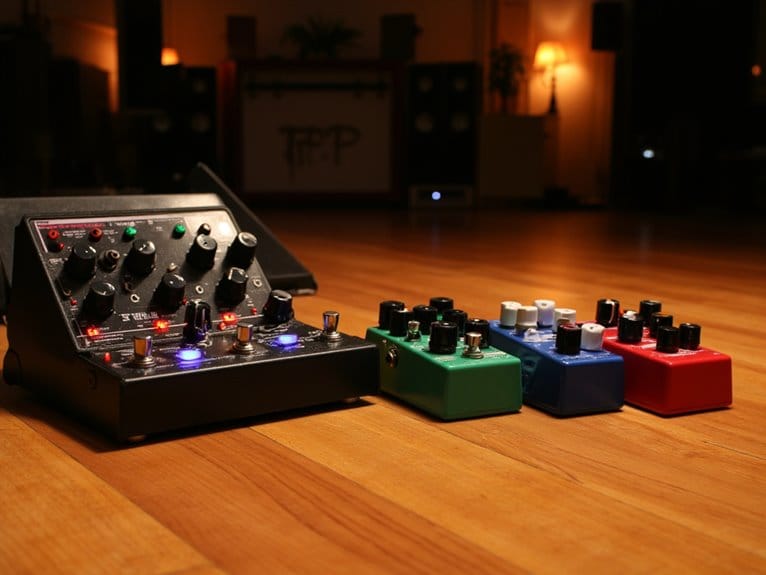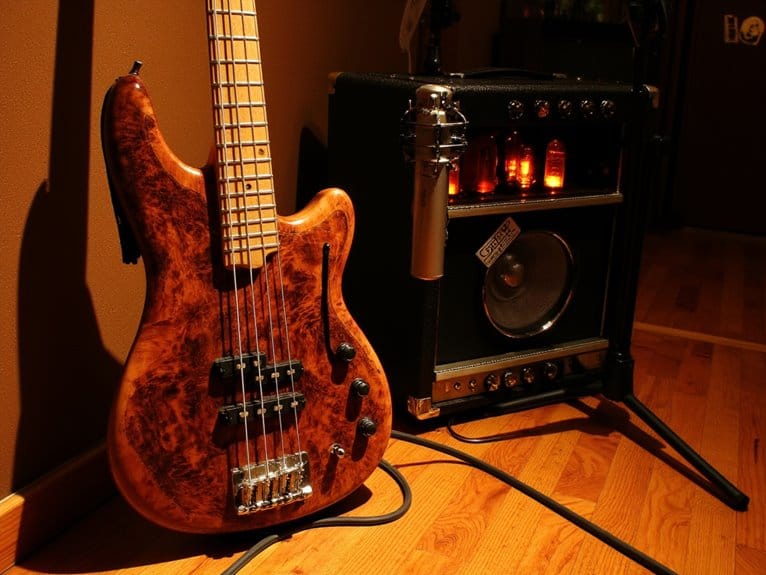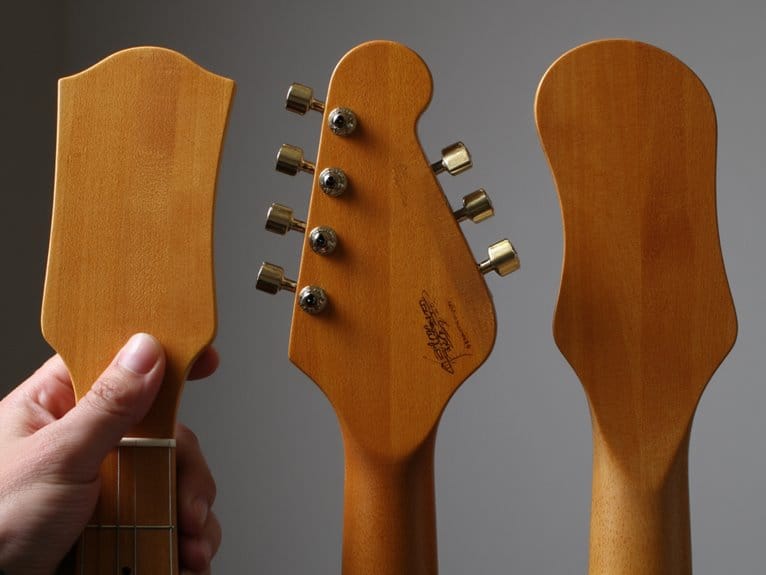Understanding Bass Guitar Nut Materials and String Spacing
Your bass guitar’s nut material greatly impacts tone and sustain, with bone delivering bright, clear resonance while synthetic options like Tusq offer ethical alternatives without sacrificing quality. Dense materials transmit vibrations more effectively than soft ones, preventing dead spots that compromise clarity. Standard 4-string spacing runs 19mm center-to-center, though fingerstyle players prefer narrower gaps around 16.5mm, while slap techniques benefit from wider arrangements that enhance comfort and technique execution across different playing styles.
We are supported by our audience. When you purchase through links on our site, we may earn an affiliate commission, at no extra cost for you. Learn more.
Notable Insights
- Bone nuts provide excellent vibration transmission and sustain while offering self-lubricating properties that improve tuning stability.
- Synthetic materials like Tusq and Corian deliver consistent tonal quality and ethical alternatives without compromising sound clarity.
- Denser nut materials transmit string vibrations more effectively, with bone offering ideal density for rich resonance.
- Standard bass string spacing ranges from 16.5mm for fingerstyle to 19-20mm for slap techniques and comfort.
- Proper nut slot depth should exceed string diameter by .003″-.005″ with .030″ clearance above the first fret.
Natural Nut Materials: Bone, Ebony, and Wood Options
When I first started exploring bass guitar modifications, I’ll admit the nut seemed like one of those “set it and forget it” components that wouldn’t dramatically impact my sound—boy, was I wrong.
Natural materials offer distinct advantages that you’ll notice immediately. Bone nuts, crafted from bleached cow bone, deliver bright, clear tones with balanced warmth while providing excellent vibration transmission for enhanced sustain. Their self-lubricating properties reduce string friction, improving tuning stability with minimal nut maintenance tips required.
Ebony presents a darker aesthetic with crisp, articulate tonal character, though you’ll need careful selection due to grain variability. Other woods like boxwood offer warmer, mellower tones but wear faster.
Natural material benefits include superior resonance and the ability to complement your instrument’s overall wood choice, though environmental factors can affect stability. Each material contributes its own sonic fingerprint that becomes part of your bass guitar’s unique voice. The nut’s role in string spacing affects playability and overall comfort during performance.
Synthetic Alternatives: Corian, Tusq, and Graphite Solutions
Although synthetic nut materials might seem like compromise solutions compared to traditional bone, I’ve discovered they often outperform natural alternatives in consistency and practical applications.
Corian benefits include exceptional uniformity between units, eliminating the tonal variations you’ll encounter with natural materials, while offering superior workability for precise slotting during installation or repairs.
Corian delivers consistent performance across all units while providing easier machining for accurate nut slot work.
Tusq applications have revolutionized the market by providing bone-like sustain and clarity without animal products, making it my go-to recommendation for players seeking ethical alternatives. When compared to plastic options, these synthetic materials avoid the dead sound that can compromise your instrument’s overall tonal quality.
Graphite-impregnated nuts solve tuning stability issues through reduced friction, particularly beneficial if you’re using tremolo systems or frequently bending strings, though I’ll admit they sometimes feel slightly different under your fingers compared to traditional materials. Similar to how wind instruments require careful positioning for optimal sound capture, proper nut installation ensures the frequency response accurately reproduces your bass guitar’s full tonal spectrum.
How Nut Material Density Affects Tone and Sustain
Understanding how nut material density affects your bass guitar’s tone and sustain requires examining the fundamental physics of vibrational energy transfer, where denser materials consistently outperform their lighter counterparts in transmitting string vibrations to the instrument’s body.
Through material comparison, bone’s ideal density provides rich resonance with balanced harmonic content, while brass offers brightness but compromises warmth. Synthetic options like Tusq deliver engineered density uniformity that often exceeds natural materials in sustain performance.
Your tonal analysis should consider how softer materials like nylon absorb vibrations, creating dead spots that diminish clarity, particularly in essential low-frequency ranges where bass guitars operate.
Harder, denser nuts maintain vibrational energy longer, directly correlating with improved sustain and enhanced harmonic complexity across your instrument’s frequency spectrum.
The split-coil pickup configuration in Precision basses works synergistically with quality nut materials to deliver the classic punchy tone that has defined the instrument across multiple decades of musical evolution.
Optimal String Spacing Measurements for Bass Guitars
Precision measurement serves as the foundation for achieving ideal string spacing on your bass guitar, where the difference between comfortable playability and frustrating technique limitations often comes down to mere millimeters.
I’ve found that proper measurement tools, including calipers and specialized rulers, make string spacing adjustments noticeably more accurate than eyeballing the layout.
Most players benefit from understanding these standard spacing dimensions:
- 4-string basses: Approximately 19mm center-to-center spacing works well for balanced technique.
- 5-string instruments: 18-20mm spacing accommodates the additional string while maintaining comfort.
- Playing style considerations: Narrower spacing (~16.5mm) suits fingerstyle, while wider spacing supports slap techniques.
Your playing preferences should ultimately guide these decisions, as ergonomic comfort directly impacts your technical development and long-term playing enjoyment.
When selecting your first instrument, consider that neck comfort significantly affects your ability to maintain proper string spacing technique, making this factor just as important as the spacing measurements themselves. Many budget-friendly instruments feature Canadian maple necks that provide excellent stability and playability without requiring expensive upgrades. Professional bassists often rely on DI output capabilities when recording, ensuring that precise string spacing translates effectively to studio quality sound.
Nut Height and Slot Precision for Maximum Playability
Three critical measurements determine whether your bass guitar’s nut delivers exceptional playability or becomes a source of constant frustration, and I’ve learned that getting these dimensions right requires more precision than most players initially expect.
Your nut slot depth should exceed string diameter by .003″ to .005″, preventing binding while maintaining proper string movement during aggressive playing. The slot bottom must sit .030″ above first fret height, ensuring adequate clearance without excessive action that’ll strain your fretting hand.
I’ve found that slot alignment across the fretboard radius keeps string height consistent, while precise nut adjustments can dramatically improve both comfort and tone quality without requiring complete replacement.
Frequently Asked Questions
Can I Replace My Bass Nut Myself or Do I Need a Professional Luthier?
You can replace your bass nut yourself with proper nut replacement tools and moderate woodworking skills. DIY bass maintenance is feasible, but consider professional help for vintage instruments or if you lack experience with precision woodworking tasks.
How Much Does Professional Nut Replacement Typically Cost for a Bass Guitar?
Professional bass nut replacement costs typically range from $30-70 total. You’ll pay $20-45 for labor plus $9-45 for materials. Factors influencing pricing include nut material quality, custom filing requirements, and your luthier’s reputation and experience level.
Do Different Nut Materials Require Specific Maintenance or Cleaning Procedures?
Yes, different nut types require specific maintenance tips. You’ll need fine steel wool for brass nuts, gentle soap cleaning for plastic, light oiling for bone, and graphite lubrication for synthetic materials to maintain peak performance.
Will Changing My Nut Material Void My Bass Guitar’s Warranty?
Changing your nut material will likely void your bass guitar’s warranty. Most manufacturers consider unauthorized modifications, including nut replacements, as alterations that nullify warranty coverage. The warranty implications depend on your specific manufacturer’s modification policies.
How Often Should a Bass Guitar Nut Be Replaced During Normal Use?
You’ll typically need replacement every few years during normal use. Replacement frequency depends on nut wear from your playing style, string gauge, and material quality rather than a fixed schedule.
On a final note
You’ll find that choosing the right nut material, whether it’s traditional bone or modern synthetic alternatives, directly impacts your bass’s tone and sustain characteristics. By carefully considering string spacing measurements, typically ranging from 19-21mm center-to-center, and ensuring precise slot heights, you’ll optimize both playability and intonation. I’ve learned that these seemingly small components make significant differences in your instrument’s overall performance and feel.

